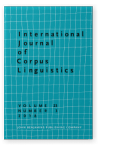The creative use of absences
A corpus stylistic approach to Henry Green’s Living
In an article published in this journal, Partington (2014) addresses the criticism often
made against corpus linguistics that it is apparently unable to cope with absences. He convincingly argues that corpus
linguistics is better suited to account for absences than has been claimed. I resume the debate by discussing a type of absence
not fully addressed in Partington (2014) which I have termed ‘creative absences’. With
a focus on corpus stylistics, I consider the way in which the author Henry Green dispenses with a compulsory element in the
grammatical structure of Standard English, i.e. the determiner (mainly, the definite article). By means of a manual analysis as
well as two corpus stylistic analyses (keyness and text-type analysis) of the novel Living (Green 1929), I explore the effects of such an unorthodox use and argue, alongside Partington (2014), for the usefulness of corpus approaches to account for at least certain types of
absences.
Article outline
- 1.Introduction
- 2.Henry Green’s Living and his theory of art
- 3.Methodology
- 4.Results of accounting for absences manually
- 5.Results of corpus-assisted analyses
- 5.1Underused tags: Wmatrix analysis
- 5.2Multidimensional functional analysis of Living: MAT
- 6.Conclusion
- Notes
-
References
References (37)
Bell, M.
(
1986)
Narrative gaps/narrative meaning.
Raritan, 6(1), 84–102.

Biber, D.
(
1988)
Variation across Speech and Writing. Cambridge: Cambridge University Press.


Biber, D.
(
1989)
A typology of English texts.
Linguistics, 27(1), 3–43.


Chatman, S.
(
1978)
Story and Discourse: Narrative Structure in Fiction and Film. Ithaca, NY: Cornell University Press.

Duguid, A.
(
2010)
Investigating anti and some reflections on modern-diachronic corpus-assisted discourse studies (MD-CADS).
Corpora, 5(2), 191–220.


Gabrielatos, C.
(
2017,
October).
Clusters of keyness. A principled approach to selecting key items. Paper presented at the Corpus Linguistics in the South 15 Conference, Cambridge, UK.
Gabrielatos, C.
(
2018)
Keyness analysis: Nature, metrics and techniques. In
C. Taylor &
A. Marchi (Eds.),
Corpus Approaches to Discourse: A Critical Review (pp. 225–258). London: Routledge.


Gabrielatos, C., & Marchi, A.
(
2011,
November).
Keyness. Matching metrics to definitions. Paper presented at the Corpus Linguistics in the South: Theoretical-methodological challenges in corpus approaches to discourse studies – and some ways of addressing them, Portsmouth, UK.
Gabrielatos, C., & Marchi, A.
(
2012,
September).
Keyness. Appropriate metrics and practical issues. Paper presented at the CADS Conference, Bologna, Italy.
Genette, G.
(
1980)
Narrative Discourse: An Essay in Method. Ithaca, NY: Cornell University Press.

Green, H.
(
1929)
Living. London: Harvill Harper Collins.

Green, H.
(
1939)
Party Going. London: Harvill Harper Collins.

Green, H.
(
1950)
The English novel of the future.
Contact, 11, 21–24.

Green, H.
(
1958)
The art of fiction. In
M. Yorke (Ed.),
Surviving (pp. 234–250). London: Harvill Harper Collins.

Greenbaum, S., & Quirk, R.
(
1990)
A Student’s Grammar of the English Language. London: Longman.

Hardy, D.
(
2005)
Towards a stylistic typology of narrative gaps: Knowledge gapping in Flannery O’Connor’s fiction.
Language and Literature, 14(4), 363–375.


Hentea, M.
(
2014)
Henry Green at the Limits of Modernism. Eastbourne: Sussex Academic Press.

Hoey, M.
(
2005)
Lexical Priming: A New Theory of Words and Language. London: Routledge.

Iser, W.
(
1978)
The Act of Reading: A Theory of Aesthetic Response. Baltimore, MD: Johns Hopkins University Press.

Mahlberg, M.
(
2013)
Corpus Stylistics and Dickens’s Fiction. New York/London: Routledge.


Mahlberg, M., Stockwell, P., de Joode, J., Smith, C., & Brook O’Donnell, M.
(
2016)
CLiC Dickens: Novel uses of concordances for the integration of corpus stylistics and cognitive poetics.
Corpora, 11(3), 433–463.


Marchi, A.
(
2010)
‘The moral in the story’: A diachronic investigation of lexicalised morality in the UK press.
Corpora, 5(2), 161–190.


Mellor, L.
(
2011)
Reading the Ruins: Modernism, Bombsites and British Culture. Cambridge: Cambridge University Press.


Nini, A.
(
2015)
Multidimensional Analysis Tagger (
Version 1.3) [Computer software]. Retrieved from:
[URL] (last accessed August 2018).
Prince, G.
(
1988)
The Disnarrated.
Style, 22(1), 1–8.

Rácz, P.
(
2012)
Operationalising salience: Definite article reduction in the North of England.
English Language and Linguistics, 16(1), 57–79.


Rayson, P.
(
2009)
Wmatrix: A Web-based Corpus Processing Environment. [Computer software]. Lancaster: Lancaster University. Retrieved from
[URL] (last access August 2018).
Quirk, R., Greenbaum, S., Leech, G., & Svartvik, J.
(
1985)
A Comprehensive Grammar of the English Language. London: Longman.

Stanford Tagger
(
2013) (
Version 3.1.5) [Computer software]. Retrieved from
[URL] (last accessed August 2018).
Stokes, E.
(
1959)
The Novels of Henry Green. London: The Hogarth Press.

Toolan, M.
(
[1988] 2001)
Narrative: A Critical Linguistic Introduction (2nd ed). London: Routledge.

Treglown, J.
(
2000)
Romancing. The Life and Work of Henry Green. London: Faber and Faber.

Wilson, P.
(
2000)
Mind the Gap. Ellipsis and Stylistic Variation in Spoken and Written English. Harlow: England.

Cited by (3)
Cited by 3 other publications
Werner, Valentin
2021.
Catchy and conversational? A register analysis of pop lyrics.
Corpora 16:2
► pp. 237 ff.

Lambrou, Marina
2019.
Telling Stories. In
Disnarration and the Unmentioned in Fact and Fiction,
► pp. 7 ff.

Statham, Simon & Rocío Montoro
2019.
The year’s work in stylistics 2018.
Language and Literature: International Journal of Stylistics 28:4
► pp. 354 ff.

This list is based on CrossRef data as of 4 july 2024. Please note that it may not be complete. Sources presented here have been supplied by the respective publishers.
Any errors therein should be reported to them.
